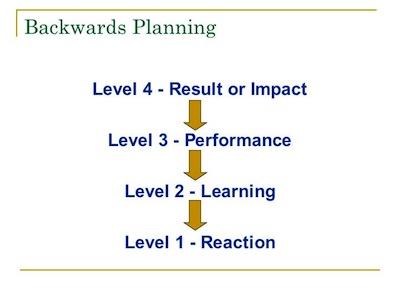Instructional Design Models, Theories & Methodology:
The Kirkpatrick Model & the Hamblin Model
The Kirkpatrick Model
Donald Kirkpatrick developed a four level model to measure the effectiveness of the training programs in 1959.The following table shows the four levels proposed by him :
Level 4 |
What kind of benefits to the organization were due to training? |
Level 3 |
How much change in the behavior of the participants (in their workplace) is due to training? |
Level 2 |
How much change in attitude and improvement in knowledge and skill is due to training? |
Level 1 |
What's the reaction of participants towards the training program? |
The following video from YouTube explains the 4 levels of Kirkpatrick Model:
Kirkpatrick's Four Levels of Evaluation
Level One - Reaction
- The evaluation at this level measures how the learners react to the training.
- This level is often measured with attitude questionnaires that are passed out after most training classes.
- This level measures one thing: the learner's perception (reaction) of the course.
- This level is not indicative of the training's performance potential as it does not measure what new skills the learners have acquired or what they have learned that will transfer back to the working environment.
- Kirkpatrick (1996) wrote, “Reaction may best be considered as how well the trainees liked a particular training program.” However, the less relevance the learning package is to a learner, then the more effort that has to be put into the design and presentation of the learning package.
Level Two - Learning
- This is the extent to which participants change attitudes, improve knowledge, and increase skill as a result of participating in the learning process.
- The learning evaluation require some type of post-testing to ascertain what skills were learned during the training.
- The post-testing is only valid when combined with pre-testing.
- Measuring the learning that takes place in a training program is important in order to validate the learning objectives. Evaluating the learning that has taken place typically focuses on such questions as: What knowledge was acquired? What skills were developed or enhanced? What attitudes were changed?
Level Three - Performance (behavior)
- This evaluation involves testing the students capabilities to perform learned skills while on the job, rather than in the classroom.
- Level three evaluations can be performed formally (testing) or informally (observation).
- It determines if the correct performance is now occurring by answering the question, “Do people use their newly acquired learnings on the job?”
- In Kirkpatrick's original four-levels of evaluation, he names this level behavior. However, behavior is the action that is performed, while the final result of the behavior is the performance.
- It is important to measure performance because the primary purpose of training is to improve results by having the students learn new skills and knowledge and then actually applying them to the job. Learning new skills and knowledge is no good to an organization unless the participants actually use them in their work activities. Since level-three measurements must take place after the learners have returned to their jobs, the actual Level three measurements will typically involve someone closely involved with the learner, such as a supervisor/teacher.
Level Four - Results
- It measures the training program's effectiveness, that is, “What impact has the training achieved?”
- Impact informs you of the return the organization receives from the training. Decision-makers prefer this.
As we move from level one to level four, the evaluation process becomes more difficult and time-consuming, however, the higher levels provide information that is of increasingly significant value.The first three-levels give you information for improving the learning package. While the fourth-level gives you the returns for investing in the learning process.
Kirkpatrick's Strengths
- Simple model
- Well known, established, and popular in many environments such as industry and professional settings
- Easy to understand
Kirkpatrick's Weaknesses
- Too simple
- Level 1 and 2 could be open to personal interpretation, conclusions may not be accurate
- Some designs suggest that there should be more levels such as impact on society and return on investment.
- No performance component for revisiting after the "four levels of training"
- May be considered "old fashioned"
- Levels 3 and 4 are not always being focused on like level 1 and 2, breaking the chain-type connection of the levels.
- Each level is is assumed to be associated with the previous and next levels
- Fails to take into account any intervening variables that may occur
Kirkpatrick's Educational Uses
Kirkpatrick says, "Trainers must begin with desired results and then determine what behavior is needed to accomplish them." (Kirkpatrick Partners, Berrett-Koehler, 1993) Many schools are going to a design based on backwards planning, starting with what the student will be able to do in the end to plan a lesson. Kirkpatrick's model supports the idea of backwards planning.

A Brief Hostory of Evaluation

Hamblin's Five Levels of Evaluation
According to Hamblin, evaluation is “any attempt to obtain information (feedback) on the effects of a training program and to assess the value of the training in the light of that information.” (Rae, 2002) To Hamblin, evaluation includes both evaluation and validation.
The Five Levels of Hamblin’s Evaluation Model: (Rae, 2002)
Level 1: Reaction
Determining the learner’s reaction to the course. Very similar to Kirkpatrick’s model where the trainers ask questions about the learners’ reactions to the course immediately following.
Level 2: Learning
Determining what the learners have learned in knowledge, skills and attitude through the course. This is very similar to Kirkpatrick’s model where the trainers assess the learning of the students.
Level 3: Job Behavior
Evaluating any change in job performance as a result of the learning in the course. Again, similar if not identical to Kirkpatrick’s model where the trainer assesses the changes in the job performance of the students after the training.
Level 4: Functioning
Determining the effect of the course on the organization as a whole such as cost benefit analysis. This is similar to Kirkpatrick’s model, however Hamblin separates this into departments/ levels of organizations and then further into the entire company or organization as described below.
Level 5: Ultimate Value
Evaluating how the event has affected the “ultimate profitability and/or survival of the organization.” This overall, company-wide level is not included in the Kirkpatrick model.
References
dmcgaughy ( Feb 3, 2011) Kirkpatrick's Four Levels of Evaluation. Retrieved August 17,2011 from http://www.youtube.com/watch?v=oBpI0B5PtaA
Clark, D. (2008). Flipping Kirkpatrick. Dec. 17, 2008. Retrieved August 20, 2011 from: http://bdld.blogspot.com/2008/12/flipping-kirkpatrick.html
Clark D. (2010 ) Kirkpatrick's Four-Level Training Evaluation Model [Video]. Retrieved August 17,2011 from http://www.nwlink.com/~donclark/hrd/isd/kirkpatrick.html
Kirkpatrick partners. (2011). The Kirkpatrick Philosophy. Retrieved August 20, 2011 from http://www.kirkpatrickpartners.com/OurPhilosophy/tabid/66/Default.aspx
Rae, L. (2002). Assessing the Value of Your Training:The Evaluation Process from Training Needs to the Report to the Board. Burlington: Gower Publishing Company
Tamkin, P, Yarnell, J, Kerrin, M, Kirkpatrick and Beyond: A Review of Models of Training Evaluation IES Report Grantham Book Services LTD. Retrieved August 27th, 2100
